#california condors
Text

California condor. Last Chance on Earth; a Requiem for Wildlife. Roger A. Caras. Illustrated by Charles Fracé. 1966.
Internet Archive
166 notes
·
View notes
Text

Apparently , the California condor lice went extinct after people removed the lice in the effort to save the condors. (Some people thought the condors are extinct- they're not, it's the lice.)
142 notes
·
View notes
Text
California agencies working to protect critically endangered condors are on high alert after 20 recent deaths in northern Arizona, wildlife officials said last week.
A highly pathogenic avian influenza that has infected domestic and wild birds across the country has been confirmed as the cause of death for California condors in in the Arizona-Utah flock. By April 17, the U.S. Fish and Wildlife Service reported 20 condors had died. So far, tests confirmed 10 of those birds were positive for the avian flu.
The virus had not been detected in condor populations in Ventura County or other parts of California and Baja as of late this week. But agencies monitoring those flocks were preparing emergency actions in case that changes, said Ashleigh Blackford, the federal agency’s California condor coordinator.
“Our concern is definitely heightened in California,” Blackford said.
More populations, more protection
Agencies have worked for decades to help the species recover. The largest flying land bird in North America — known for its bald head and black feathers — had all but disappeared in the wild by the early 1980s.
The population dropped to just 22 birds in the wild in 1982. Five years later, all remaining wild condors were placed in a captive breeding program to save the species from extinction.
By the end of last year, 347 condors lived in the wild – 183 in California and 116 in the Arizona-Utah region.
Supporting separate populations in different areas was part of the plan to help the species overcome any single event such as a virus outbreak or wildfire. The more populations and the more birds increases the odds of survival, Blackford said.
The condors also continue to rely on captive-bred birds being released into the wild.
Virus can be fatal
The avian influenza can spread quickly and appears to be almost 100% fatal for some species. But scientists didn’t know until the recent outbreak how infected condors would fare.
“Now, we know that answer, and it is an unfortunate answer," Blackford said.
But some condors do appear to be recovering. Eight sick condors were captured in Arizona and brought to a facility for treatment. Of those, four died and four others are still receiving care and showing signs of improvement, wildlife officials said.
A setback for Arizona flock
The 20 recent deaths account for around 17% of the Arizona-Utah flock. That's four times the number of deaths in the region last year.
"That’s a substantial setback for this flock," Blackford said. "But it is not insurmountable."
In all of last year, the agency reported 20 condor deaths, most of them in California. Lead poisoning is consistently the leading the cause of death and continues to be the biggest concern for agencies working to protect the species.
The birds feed on carcasses containing bullet fragments, so trying to get folks to use other types of ammunition continues to be a priority, wildlife officials said. Lead poisoning not only can be fatal but also can suppress the immune system, increasing the condors risk from other illnesses.
"If we were not losing birds to lead, then our population would be stronger," Blackford said. "It would be more robust, and we would have healthier birds."
How to help
While the risk to the public's health is low, officials said human infections can happen and the general public should avoid handling wild birds. State and federal agencies recommended the following tips.
Report dead birds using the state's mortality reporting system to help officials monitor the outbreak at wildlife.ca.gov/Living-with-Wildlife.
If you see condors, observe from a distance. Stress can be harmful to birds exhibiting symptoms of illness.
Keep your family, including pets, a safe distance away from wildlife. Do not feed, handle or approach sick or dead animals or their droppings.
Prevent contact of domestic or captive birds with wild birds.
Find more information about the avian influenza: cdfa.ca.gov/ahfss/Animal_Health/Avian_Influenza.html, aphis.usda.gov/aphis/ourfocus/animalhealth/animal-disease-information.
#California condors#California condor#raptors#birds of prey#birds#animals#wildlife#nature#vultures#avian flu#endangered species#extinction#animal death
294 notes
·
View notes
Link
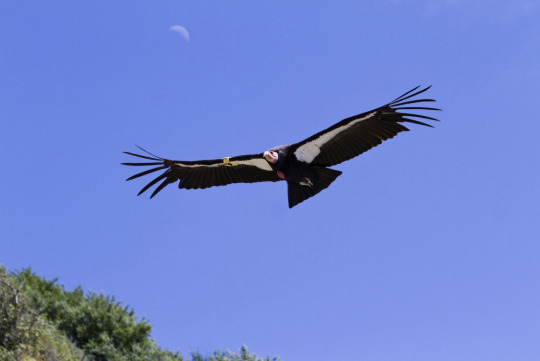
Excerpt from this story from EcoWatch:
youtube
Excerpt from this story from EcoWatch:
For the first time in more than a century, endangered California condors soared over the redwood forests along the state’s northern coast.
The two birds, both males, were released from a pen in Redwood National Park on Tuesday morning, AP News reported.
“That was just as exciting as I thought it was going to be,” Yurok Tribe wildlife department director Tiana Williams-Claussen told Jefferson Public Radio. “Those guys just took right off.”
A video shared by the Yurok Tribe on Facebook shows first one and then the other bird emerging from the pen and launching themselves into flight.
The Yurok Tribe has spearheaded efforts to reintroduce the California condor to the northern part of its range. In 2021, the tribe announced a new condor release facility with the U.S. Fish and Wildlife Service and the National Park Service, with the goal of reintroducing the birds to Yurok Ancestral Territory and Redwood National Park. The Yurok Tribe considers the condors sacred, and the construction of the facility was the result of years of work on its part.
9 notes
·
View notes
Text
Went with my besties and my little nephew to a nearby zoo* yesterday. Didn't know that they had California Condors until I saw banners about them as we were driving up.
I proceeded to start chanting "condors! Condors! CONDORS!" like a gleeful child.
When I got to the Condors I was sure to tell the big, gorgeous birds that they are big and gorgeous and that their neck feathers look fabulous.
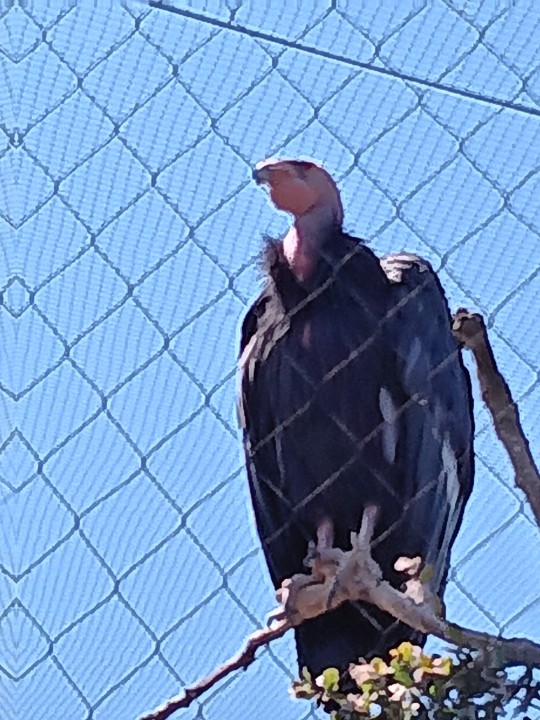
This one was watching us as much as we were watching them:
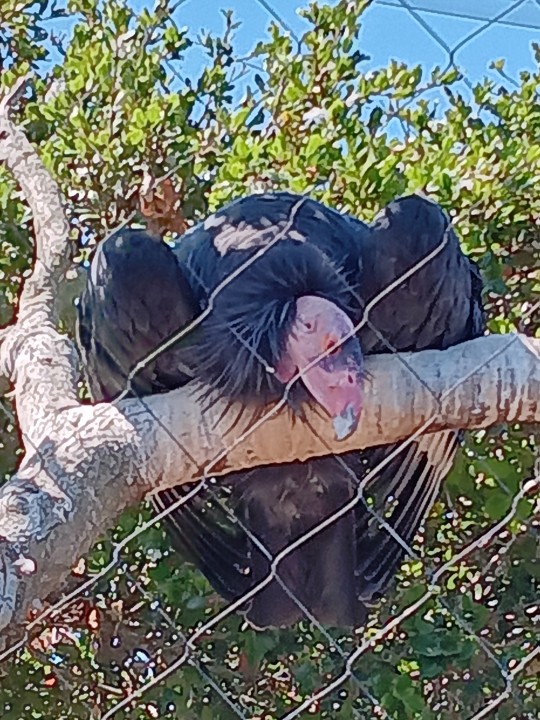
I still want to go see California Condors in the wild someday.
*this particular zoo takes proper care of their animals and sources them ethically. Many of them are rescues that couldn't be returned to the wild. California Condors in particular are an endangered species that were brought back from the brink of extinction by captive breeding programs.
#birds#birdblr#one of my favorite birds#California Condors#condors#endangered species#birding#bird watching#birbs
0 notes
Text

California Condor, Gymnogyps californianus, a critically endangered Pleistocene vestige.
2K notes
·
View notes
Text
LINK FEST: 12 JULY
LINK FEST: 12 JULY
Links that may or may not be related to gardens, food, travel, nature, or heterotopias and liminal spaces but probably are. Sources in parentheses.
field guide to July (Vermont Center for EcoStudies): Bees, chanterelles, squash vine borer moths, black bear breeding season, native mussels, buttonbush, Indian ghost pipe, sarsaparilla, daisies, lobelia, and the Eastern Whip-poor-will, if you’re…

View On WordPress
#bees#birds#California condors#condors#field guide#intensity#Japan#Japanese native bees#July#life#link fest#links#living on earth#mt cuba center#New England#rosecrans baldwin#summer plants
0 notes
Text

California condor. These are Endangered; written by Charles Cadieux and illustrated by Bob Hines. 1981.
Internet Archive
101 notes
·
View notes
Text

My gift for @mathpope from a recent discord “secret Santa” art exchange! I give you the great California Condor, king of North American vultures, lording over a megafaunal feast.
Some notes on the border art: the tree branch flourishes up top depict bristlecone trees, another unique Pleistocene holdover that clings to existence in remote parts of California. The insects in the curve of the mammoth tusks are condor lice (Colpocephalum californici), a parasite that fed exclusively on California condors and went extinct when the 22 birds left in existence were captured and de-loused for the breeding program to save their species. The woven art on the sides depicts two indigenous myths about condors, left side as a beneficial entity, saving humanity from a primordial flood (Wiyot), and right side as a bloodthirsty antagonist that gets beheaded by Ground Squirrel (Mono). The bones overhead (mammoth, moose, horse) are all Pleistocene megafauna that the condor would have been specialized in feeding on.
Thanks for another fun trade!
735 notes
·
View notes
Text
24 Year Sentence for Dolan Fire Arsonist
Arsonist Kills 12 Endangered Birds, Receives 24 Year Sentence
A 24 year sentence has been given to the man who started the Dolan fire in Big Sur in 2020, which destroyed 125,000 acres and killed 12 endangered condors.
The Dolan fire began on an illegal cannabis farm in Monterey County on August 18, only a mile south of the Big Sur Condor Sanctuary, where the critically endangered raptors have been bred and released since 1997. The entire 80-acre site was…
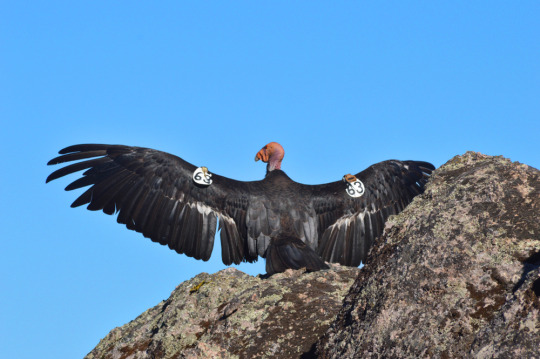
View On WordPress
1 note
·
View note
Text
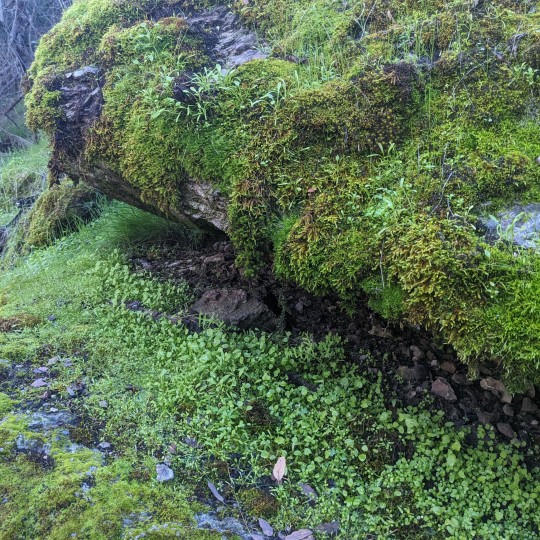


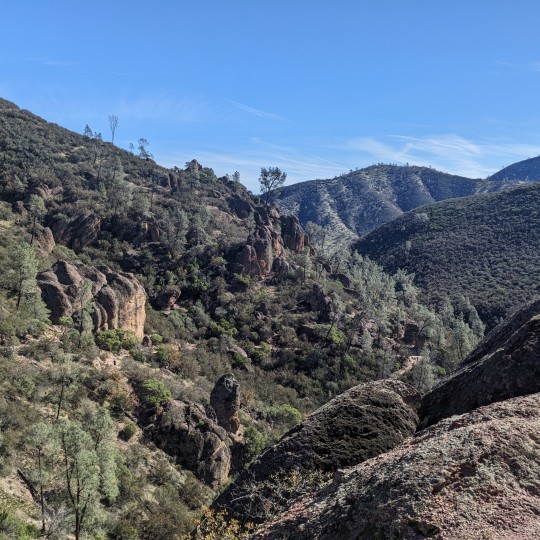
went to pinnacles and had a whale of a time seeing various lichens, mosses, etc
#also two california condors who used to be in a throuple#not pictured until boyfriend gets his full res photos sorted.#ive never been to pinnacles before and spent a lot of it being like#THIS part is just like henry coe and THIS part is just like alum rock and THIS part reminds me of the sierras!#but ofc the rocks are really their own thing.#beeyootiful park
242 notes
·
View notes
Text
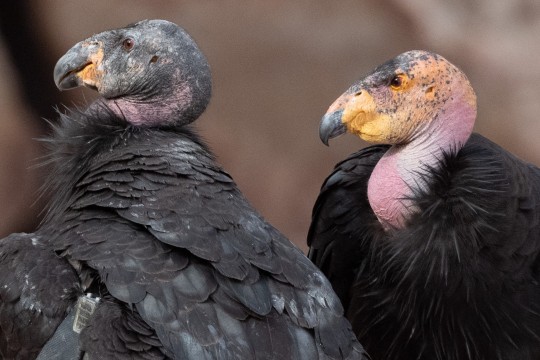
[1994/11056] California condor - Gymnogyps californianus
Order: Accipitriformes
Family: Cathartidae (new world vultures)
Photo credit: Cynthia Case via Macaulay Library
261 notes
·
View notes
Text
BOTD: California Condor

Photo: Donna Pomeroy
"A holdover from prehistoric times, the great condor is one of our largest and most magnificent birds -- and one of the rarest. Soaring over wilderness crags, feeding on carcasses of large dead animals, reproducing very slowly, it was not well suited to survival in modern-day southern California. Headed toward extinction in the 1980s, the last birds were brought in from the wild in 1987, to be bred in captivity for eventual release into the wild again. The captive breeding program turned out to be surprisingly successful, and flocks of released condors are surviving in several areas of California and in the region of the Grand Canyon."
- Audubon Field Guide
#birds#california condor#birds of north america#north american birds#condors#vultures#raptors#birds of the us#birds of mexico#birding#birdblr#birblr#bird watching#bird of the day#Gymnogyps californianus
163 notes
·
View notes
Link
Excerpt from this story from EcoWatch:
Despite being banned since the 1970s, DDT and PCBs are still affecting wildlife today, particularly the California condor, a critically endangered species. The condors feed on dead marine life along the California coast that often contain higher amounts of contaminants compared to marine life elsewhere.
Scientists at San Diego State University (SDSU) and San Diego Zoo Wildlife Alliance (SDZWA), in collaboration with Centro de Investigación Científica y de Educación Superior de Ensenada and the National Oceanographic and Atmospheric Administration (NOAA), conducted research and found that dead marine life along California’s coast had about seven times more DDT and 3.5 times as much PCBs compared to dead marine life near Baja California, Mexico.
The findings, published in Environmental Science & Technology, showed that California condors living in coastal areas of the state had higher levels of contaminants in their blood compared to inland condors, which do not feed on marine life. DDT levels in coastal condors were about seven times higher than inland condors, and PCBs were about 40 times higher.
The researchers further found over 400 contaminants in total in the marine life samples, which are a common food source for the condors.
1 note
·
View note
Text

💥 PUNK CONDOR ADOPT! 💥
today, september 2nd, is international vulture awareness day! this condor is up for USD offers - winner will donate the amount directly to the peregrine fund OR yurok tribe condor conservation programs! see replies for toyhouse link :]
#anthro#furry#fursona#anthro avian#anthro vulture#vulture#condor#california condor#punk#queer#lgbt#lesbian#trans#sfw furry#clean furry#adopt#adoptable#open adopt#character design#stanley does art
206 notes
·
View notes